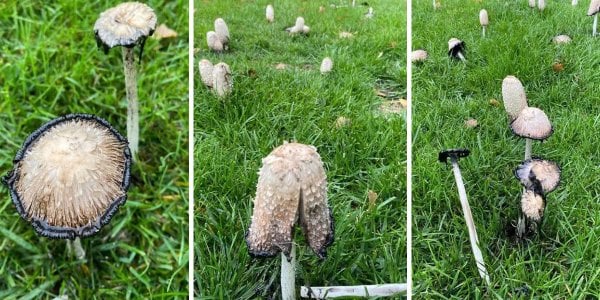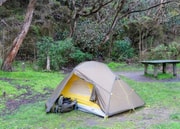Aussie woman's mushroom mystery sprouts debate and digestive dilemmas!
- Replies 9
As the seasons change and the weather shifts, backyards can become the stage for some truly unexpected guests.
For one Australian woman, it was a sudden and bewildering mushroom invasion that prompted a flurry of questions and concerns.
With her lawn transformed by these 'interesting' intruders, she took to social media to seek advice, sparking a debate that many might find both familiar and intriguing.
Mushroom season, a time when fungi flourish, had arrived, and with it, a Northern Tablelands resident in New South Wales saw a garden overtaken by an unusual-looking fungi infestation.
The homeowner's primary concern was whether these mushrooms posed any danger to people or pets. She expressed her uncertainty regarding her plan to mow them down after the rain ceased on social media.
Some argued that mowing was the right approach, while others warned that it could spread the spores and worsen the growth.
However, the discussion didn't stop at lawn care tactics; it branched out into the realm of culinary curiosity: could these mushrooms be a free and fresh addition to dinner?
Opinions varied, with some advocating for their edibility while others cautioned against the risks, labelling it 'too dangerous'.

Foraging for wild mushrooms could be a delightful pastime, but it's not without its perils.
Professor Brett Summerall, the Chief Scientist at the Botanic Gardens of Sydney, advised against picking wild fungi.
He identified the mushrooms in the woman's photos as belonging to the Coprinus species, specifically the smaller, darker ‘ink cap’ and the taller ‘shaggy ink cap’, ‘shaggy mane’ or ‘lawyer’s wig’.
These fungi are no strangers to Canberra, the Southern Tablelands, and the South Coast of NSW.
‘They are a pretty common species that come up in people’s lawns, gardens, grass areas, paddocks, pasture and the like,’ Professor Summerall said.
‘What is interesting about the species is that they auto-digest—they will fade away into an inky fluid or puddle very quickly. They are up there for a relatively short period of time.’
Professor Summerall mentioned that this process could be completed in under a day, ensuring the mushrooms would likely disappear before anyone could even fetch their lawnmower.
‘They release their spores and break down very quickly into a slimy mess,’ he explained.
‘Technically they are edible but you should not consume alcohol with them as you can get quite a bad allergic reaction, like a nausea-type reaction.’
While they might taste delicious when pureed and cooked in a soup with onions and potatoes or in an omelette, Professor Summerall's response was, ‘Why would you?’
The mushroom expert's stance was clear: Do not pick wild mushrooms unless you are highly knowledgeable about them.
‘It’s best to just leave them, best not to pick anything,’ he suggested.
‘Pine mushrooms are pretty safe but anything else is pretty risky.’
Professor Summerall stated that mushroom season typically lasts from May to June and recent heavy rain led to a sudden surge in mushroom growth, prompting emergency departments to seek his expertise in identifying wild species after people fell ill from consuming them.
‘The wetter conditions are perfect for them, you will see lots of species coming up at the moment in abundance,’ he said.
‘However, my advice is—if you want to go out foraging, check the shelves in Woolworths or Coles.’
The social media post certainly stirred up a conversation.
While many recognised the mushrooms and acknowledged their commonality, the consensus on their safety was split.
‘Don’t eat anything that grows on your lawn,’ one commenter warned.
Another agreed, saying ‘Given they can kill, I only eat mushrooms I can purchase from shops that are known to be edible.’
Others reported witnessing similar mushroom outbreaks in their own gardens.
As one Australian woman grapples with an unexpected mushroom explosion on her lawn, it serves as a timely reminder of the potential dangers lurking in our gardens.
While mushrooms might seem harmless, they can sometimes pose risks, especially when they're of the wild variety.
This recent incident highlights the importance of staying vigilant and knowing how to handle unexpected garden intruders.
In a similar vein, a Melbourne resident recently uncovered a more sinister menace in their backyard, underscoring the need for caution when exploring outdoor spaces.

Have you encountered a similar situation in your garden? What steps did you take to address it? Share your stories and tips in the comments below!
For one Australian woman, it was a sudden and bewildering mushroom invasion that prompted a flurry of questions and concerns.
With her lawn transformed by these 'interesting' intruders, she took to social media to seek advice, sparking a debate that many might find both familiar and intriguing.
Mushroom season, a time when fungi flourish, had arrived, and with it, a Northern Tablelands resident in New South Wales saw a garden overtaken by an unusual-looking fungi infestation.
The homeowner's primary concern was whether these mushrooms posed any danger to people or pets. She expressed her uncertainty regarding her plan to mow them down after the rain ceased on social media.
Some argued that mowing was the right approach, while others warned that it could spread the spores and worsen the growth.
However, the discussion didn't stop at lawn care tactics; it branched out into the realm of culinary curiosity: could these mushrooms be a free and fresh addition to dinner?
Opinions varied, with some advocating for their edibility while others cautioned against the risks, labelling it 'too dangerous'.

A NSW Northern Tablelands resident found a strange mushroom outbreak in her garden during mushroom season. Credits: Facebook
Foraging for wild mushrooms could be a delightful pastime, but it's not without its perils.
Professor Brett Summerall, the Chief Scientist at the Botanic Gardens of Sydney, advised against picking wild fungi.
He identified the mushrooms in the woman's photos as belonging to the Coprinus species, specifically the smaller, darker ‘ink cap’ and the taller ‘shaggy ink cap’, ‘shaggy mane’ or ‘lawyer’s wig’.
These fungi are no strangers to Canberra, the Southern Tablelands, and the South Coast of NSW.
‘They are a pretty common species that come up in people’s lawns, gardens, grass areas, paddocks, pasture and the like,’ Professor Summerall said.
‘What is interesting about the species is that they auto-digest—they will fade away into an inky fluid or puddle very quickly. They are up there for a relatively short period of time.’
Professor Summerall mentioned that this process could be completed in under a day, ensuring the mushrooms would likely disappear before anyone could even fetch their lawnmower.
‘They release their spores and break down very quickly into a slimy mess,’ he explained.
‘Technically they are edible but you should not consume alcohol with them as you can get quite a bad allergic reaction, like a nausea-type reaction.’
While they might taste delicious when pureed and cooked in a soup with onions and potatoes or in an omelette, Professor Summerall's response was, ‘Why would you?’
The mushroom expert's stance was clear: Do not pick wild mushrooms unless you are highly knowledgeable about them.
‘It’s best to just leave them, best not to pick anything,’ he suggested.
‘Pine mushrooms are pretty safe but anything else is pretty risky.’
Professor Summerall stated that mushroom season typically lasts from May to June and recent heavy rain led to a sudden surge in mushroom growth, prompting emergency departments to seek his expertise in identifying wild species after people fell ill from consuming them.
‘The wetter conditions are perfect for them, you will see lots of species coming up at the moment in abundance,’ he said.
‘However, my advice is—if you want to go out foraging, check the shelves in Woolworths or Coles.’
The social media post certainly stirred up a conversation.
While many recognised the mushrooms and acknowledged their commonality, the consensus on their safety was split.
‘Don’t eat anything that grows on your lawn,’ one commenter warned.
Another agreed, saying ‘Given they can kill, I only eat mushrooms I can purchase from shops that are known to be edible.’
Others reported witnessing similar mushroom outbreaks in their own gardens.
As one Australian woman grapples with an unexpected mushroom explosion on her lawn, it serves as a timely reminder of the potential dangers lurking in our gardens.
While mushrooms might seem harmless, they can sometimes pose risks, especially when they're of the wild variety.
This recent incident highlights the importance of staying vigilant and knowing how to handle unexpected garden intruders.
In a similar vein, a Melbourne resident recently uncovered a more sinister menace in their backyard, underscoring the need for caution when exploring outdoor spaces.
Key Takeaways
- A NSW Northern Tablelands resident encountered an unusual fungi infestation in her garden during mushroom season.
- There was a debate on whether mowing down the mushrooms would be beneficial or cause more to grow, coupled with mixed advice on whether the mushrooms were safe to eat.
- Professor Brett Summerall advised against picking wild mushrooms, particularly the Coprinus species found in the resident's garden, citing potential health risks.
- Mushroom season was linked to wetter conditions, and people were advised to forage for mushrooms at supermarkets like Woolworths or Coles rather than in the wild due to safety concerns.







